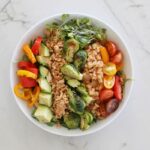Craving noodles but sticking to your paleo lifestyle? This isn’t a culinary contradiction! Discover a world of quick and satisfying paleo-friendly noodle alternatives, from vibrant zucchini spirals to hearty kelp noodles. We’ll explore simple, flavorful sauces that transform these substitutes into delicious, nutritious meals, perfect for busy weeknights. Get ready to unlock a range of recipes, each crafted for speed and packed with flavor, ensuring your paleo journey is anything but bland.
We’ll guide you through selecting the ideal noodle substitute based on texture and nutritional profile, teaching you how to prepare flavorful sauces in minutes. Five complete recipes, each under 30 minutes, will showcase the versatility of paleo noodles. Learn adaptation techniques to customize your dishes, adding your favorite proteins and vegetables. Prepare for a culinary adventure that’s both healthy and incredibly delicious!
Quick Paleo Noodle Alternatives

Craving noodles but sticking to your paleo diet? Fear not! Several delicious and nutritious alternatives exist that mimic the satisfying texture and versatility of traditional noodles without compromising your dietary principles. These options provide a range of nutritional benefits and textures, allowing you to explore diverse culinary possibilities within your paleo lifestyle.
Paleo Noodle Substitute Options
Choosing the right paleo noodle substitute depends on your preferred texture and the dish you’re preparing. Each option offers a unique culinary experience. Below, we explore five popular choices, detailing their nutritional profiles, textures, and cooking methods.
| Noodle Type | Nutritional Information (per serving, approximate) | Texture | Cooking Method |
|---|---|---|---|
| Zucchini Noodles (Zoodles) | Low in calories, high in water content, good source of Vitamin C and potassium. | Delicate, slightly soft, prone to becoming mushy if overcooked. | Spiralized using a vegetable peeler or spiralizer; sautéed, steamed, or eaten raw. |
| Sweet Potato Noodles | Rich in Vitamin A, fiber, and carbohydrates. | Slightly firm when cooked, with a mild sweetness. Holds its shape better than zoodles. | Spiralized or julienned; sautéed, roasted, or stir-fried. |
| Shirataki Noodles | Very low in calories and carbohydrates, primarily composed of glucomannan fiber. | Unique, slightly gelatinous texture. Can be slightly slippery. | Requires rinsing thoroughly before use to remove excess odor; sautéed, added to soups or stir-fries. |
| Kelp Noodles | Good source of iodine, low in calories and fat. | Naturally translucent and slightly chewy; can become tough if overcooked. | Soaked in water until softened; added to salads, soups, or stir-fries. |
| Cauliflower Rice (as a noodle alternative in certain dishes) | High in Vitamin C, fiber, and antioxidants. | Fluffy and light; absorbs flavors well. Best suited for dishes where a more granular texture is desired. | Pulsed in a food processor until rice-like; sautéed, roasted, or steamed. |
Simple & Flavorful Paleo Sauces
Creating delicious and quick paleo sauces is key to elevating your noodle dishes. These recipes focus on simple ingredients and bold flavors, transforming your meal from ordinary to extraordinary in minutes. Each sauce offers a distinct flavor profile, perfectly complementing various protein choices.
Peanut Ginger Sauce
This sauce delivers a vibrant blend of sweet, savory, and spicy notes. The rich peanut butter provides a creamy base, while the ginger and garlic add a zesty kick. A touch of lime juice brightens the flavors, creating a truly unforgettable experience.
Ingredients:
- 1/4 cup creamy peanut butter (ensure it’s free of added sugars and other non-paleo ingredients)
- 2 tablespoons rice vinegar
- 1 tablespoon soy sauce (tamari for gluten-free)
- 1 tablespoon grated fresh ginger
- 1 clove garlic, minced
- 1 tablespoon lime juice
- 1 teaspoon sesame oil
- 1/2 teaspoon red pepper flakes (optional, for added heat)
Instructions:
- In a small bowl, whisk together the peanut butter, rice vinegar, soy sauce, ginger, garlic, lime juice, sesame oil, and red pepper flakes (if using) until smooth and creamy.
- Taste and adjust seasonings as needed. You may want to add more lime juice for acidity, or more soy sauce for saltiness.
- Serve immediately over your favorite paleo noodles and protein.
Flavor Profile: Sweet, savory, spicy, and tangy. Pairs well with chicken, shrimp, or tofu.
Spicy Coconut Curry Sauce
This sauce offers a rich and aromatic flavor profile, thanks to the coconut milk and a blend of warming spices. The hint of sweetness from the coconut milk balances the heat from the chili flakes, creating a harmonious taste sensation.
Ingredients:
- 1 can (13.5 oz) full-fat coconut milk
- 1 tablespoon coconut aminos
- 1 teaspoon curry powder
- 1/2 teaspoon turmeric
- 1/4 teaspoon red pepper flakes
- 1/4 teaspoon ground ginger
- Salt and pepper to taste
Instructions:
- In a small saucepan, combine all ingredients and bring to a simmer over medium heat.
- Reduce heat to low and simmer for 5-7 minutes, stirring occasionally, until the sauce has thickened slightly.
- Taste and adjust seasonings as needed. Add more red pepper flakes for extra heat, or more coconut aminos for saltiness.
- Serve immediately over your favorite paleo noodles and protein.
Flavor Profile: Rich, creamy, spicy, and aromatic. Pairs well with beef, pork, or vegetables.
Tangy Lemon Herb Sauce
This bright and zesty sauce is perfect for those who prefer a lighter, more refreshing option. The lemon juice provides a vibrant acidity, while the fresh herbs add a burst of herbaceousness. It’s a simple yet sophisticated sauce that elevates any noodle dish.
Ingredients:
- 1/4 cup olive oil
- 2 tablespoons lemon juice
- 1 tablespoon chopped fresh parsley
- 1 tablespoon chopped fresh dill
- 1 clove garlic, minced
- Salt and pepper to taste
Instructions:
- In a small bowl, whisk together the olive oil, lemon juice, parsley, dill, garlic, salt, and pepper until well combined.
- Taste and adjust seasonings as needed. Add more lemon juice for extra tanginess, or more salt and pepper to taste.
- Serve immediately over your favorite paleo noodles and protein.
Flavor Profile: Bright, zesty, and herbaceous. Pairs well with chicken, fish, or shellfish.
Embarking on a paleo diet doesn’t mean sacrificing your noodle cravings. This guide has armed you with the knowledge and recipes to create quick, satisfying, and flavorful paleo noodle dishes. From mastering the art of sauce-making to adapting recipes to your preferences, you’re now equipped to enjoy a wide variety of healthy and delicious meals. So, ditch the processed noodles and embrace the vibrant world of paleo noodle cuisine – your taste buds will thank you!
FAQ
Can I use regular soy sauce in paleo recipes?
No, regular soy sauce contains gluten and is not paleo-friendly. Use coconut aminos or tamari (ensure it’s gluten-free) as alternatives.
Are all shirataki noodles created equal?
No, the quality and taste of shirataki noodles can vary depending on the brand and processing. Look for reputable brands with minimal additives.
How can I store leftover paleo noodles?
Store leftover paleo noodles in an airtight container in the refrigerator for up to 3-4 days. Reheat gently to avoid overcooking.
What are some good substitutes for peanut sauce if I have allergies?
Cashew cream, tahini, or even a simple lemon-herb vinaigrette can make excellent substitutes for peanut sauce.


